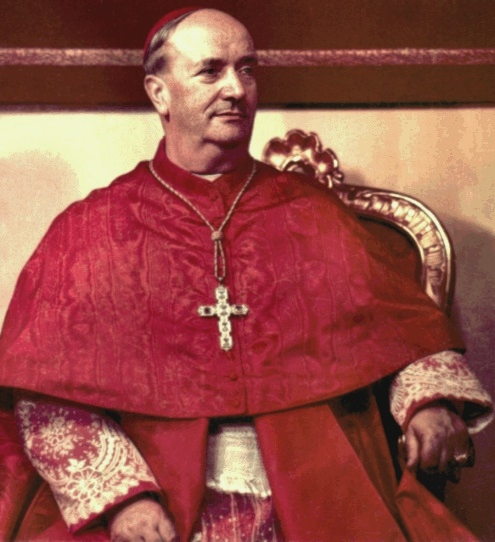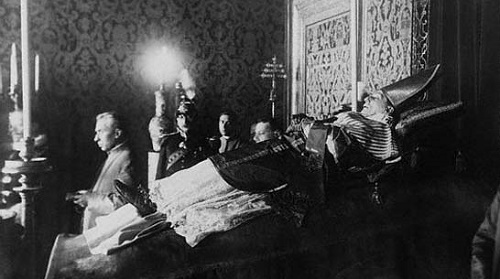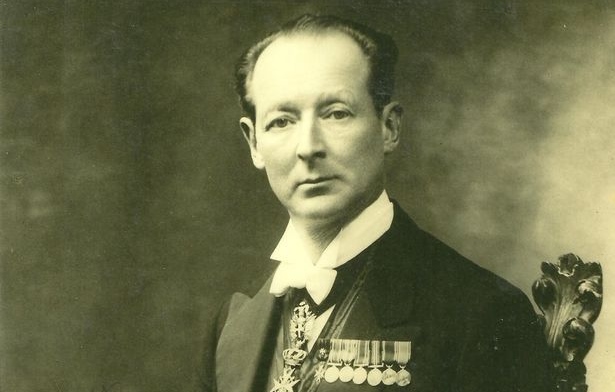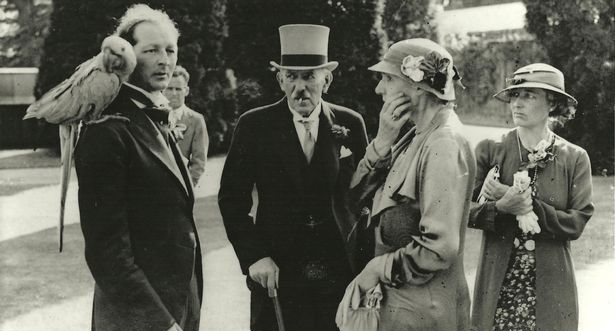Claudio Cesare Gagne-Bevilacqua was born to a moneyed family in Iseo in 1898, in a third-story bedroom in one of the city’s stateliest mansions. His father was a railway executive for a private line owned by a Lombard Marquis. The Gagne-Bevilacquas had profited handsomely from the 19th century industrial boom in northern Italy, and the consequent expansion in rail. (It was a fortuitous time to be a railway executive). The baby’s Christian name was given to him after the Roman emperor Claudius Caesar: the boy had been born with unequal leg lengths; his left leg was a full four centimeters shorter than his right. It was clear that the child would eventually walk with a distinct limp; the emperor, who was club-footed, had also limped. “My father was very fond of Roman Antiquity, and he had a morbid sense of humor also,” recalled Gagne-Bevilacqua of his papà. “And therefore I was Claudio Cesare. Besides, I was the ninth child, and I was the runt. At that point, I suppose, my parents could be cavalier with names.”
Roger Morgan (the father of this blogger) met with Claudio Gagne-Bevilacqua in January of 1986 in Turin. The following is excerpted from his notes and transcripts of his first visit to Gagne-Bevilacqua’s apartment.
He is a short man, and squat; coarse-looking and swarthy—almost dwarfishly short, in fact, perhaps five feet tall. My first impression is of Toulouse-Lautrec (had Toulouse-Lautrec, perhaps, lived into old age). He walks with a distinct hobble owing to a birth defect in his left femur. His left shoe has a modified sole to correct for this, but it helps only so much. Nevertheless he has an elfin agility and sprightliness, even for a man of his advanced years (he is eighty-seven).
I am impressed at the strange grace and deft with which he maneuvers around his flat. Meeting him and observing him, one is reminded of two fictional bell-ringers: Hugo’s Quasimodo and Huysmans’ Carhaix. He has Quasimodo’s simian dexterity in spite of his handicap (I can easily picture this old fellow swinging from the ropes of a bell tower), and he has the unassuming piety and good-sense traditionalism of Carhaix. One imagines him excelling in his lifelong service as a valet. This man exemplifies old-fashioned sturdiness and efficiency.
He goes to a bureau, opens a drawer, and locates an old photograph. He hobbles back over and hands it to me. It’s a relic of a picture, with all the scratches and speckles of a daguerreotype: it’s the entering class of first-year students at the Brescia Seminary in 1916, the order of acolyte. He doesn’t need to point himself out—I can locate him immediately: a dwarfish little thing standing in the front row, wearing a cassock too long for him that falls onto his shoes, one of which has a lifted sole. He’s probably the best-looking young man in the class, though. The youthful Gagne-Bevilacqua possesses an oddball handsomeness: a darkly aristocratic look (thick brow, heavy-lidded eyes, and thin lips) tempered with a droopy hangdog tinge: a nose slightly too big and a face slightly too long. And then I realize who he truly reminds me of: Al Pacino. In this photo he is the early Al Pacino, circa The Panic in Needle Park. I remark on this.
RM: Begging your pardon, Signore. Has anyone ever told you you resemble the actor Al Pacino in this picture?
CGB: (shakes head) I do not know who this person is.
RM: He’s a famous American actor. Surely you’ve seen, or heard of, the Godfather movies?
CGB: No. I am sorry. I have not been to the cinema since the 1960s. La Dolce Vita. I found it scandalous.
My father was a massive cinephile, so it’s unsurprising he would steer the conversation in that direction so soon. Two things stand out to me, however, reading these notes and transcripts more than thirty years later. The first is that, in 1986, the Godfather movies consisted of only two installments. A third entry in the series came out in 1990, and part of its plotline included a conspiracy to murder John Paul I. The reasons for the assassination in the movie are purely fictional (and completely wrong), but it is interesting that the movies were mentioned here in passing since, on the fourth day of their interviews, Gagne-Bevilacqua would inform my father of the true details of the actual murder of John Paul I in 1978. The second thing is that my father had been struck by the physical resemblance of two different men born generations apart. What Gagne-Bevilacqua pointed out to him next, however, was even more striking: the uncanny similarities between two of the boys in the very same photo. On the far left was Giovanni Battista Montini, the future Pope Paul VI. In the middle of the right side was Alessandro Falchi.
We can only surmise at what the young Montini must’ve thought upon first meeting his doppelgänger at seminary. In mythology, the doppelgänger represents the dark half—and this aspect, indeed, would prove true: Falchi would turn out to be wicked soon enough. And just as in Dostoevsky’s story of a man who meets his double, the evil twin in this case would eventually come to bedevil his counterpart, overtaking his life and eventually replacing him altogether. But a doppelgänger is also said to be a portent of death (when the poet Shelley saw his double, the other Shelley pointed wordlessly to the Tyrrhenian Sea where he would eventually drown). Not so with Montini’s counterpart, however. Alessandro Falchi died in 1978; Pope Paul VI is yet still alive.
At the time, Gagne-Bevilacqua was not privy to how Montini himself felt about any of this. “I knew Montini hardly at all during my year in seminary,” he said. “He had some health problems, and he did not live on the campus. He stayed at home, and was driven back and forth each day. I don’t remember much about him. He was of average intelligence, I would say. Generally well-liked. I’m afraid he didn’t make much of an impression at the time. There was no indication he would one day become pope. What I recall mostly is that he looked so much like Falchi. Everyone was amazed at how they could almost pass for twins. And Falchi, of course, I got to know very well. We were assigned to share the same dormitory room.”
According to his first-year roommate, Falchi did not care for Montini. Much of their physical similarity was remarkable: the same-shaped jawline, identical pairs of piercing eyes, and equally aquiline Roman noses. But Falchi had poor eyesight, and wore a thick and unflattering pair of glasses. He also wore his hair extremely short, shorn down to just a coarse stubble—because to grow it out would reveal tight kinky curls, which he hated. “He despised his hair. He was terribly vain,” related Gagne-Bevilacqua. From the transcript:
CGB: He was very superficial. Perhaps it bothered him that Montini had nicer hair and didn’t wear glasses. I don’t know. But for some reason he resented him. Falchi was fixated on his own looks. He was frequently in front of the mirror, you see: shaving his chin, tweezing his nose hairs, plucking his brow. I was appalled he was even in seminary in the first place. He was obsessed with his looks, and he seemed determined to commit as many sins of the flesh as he could. I knew for a fact he was carrying on with a lower-class girl named Lia who lived in town, and that he impregnated her. She kept the paternity of the child a secret, and she and her mother raised it on their own. Falchi’s only contribution to the child was to name it Federico.
RM: After Engels, I presume? You’ve told me Falchi was a communist.
CGB: No, after Nietzsche. He became a communist much later. Who knows what he really believed. Falchi was simply a sieve, in my opinion, catching anything which was contrary to the faith, and letting anything that was pure slip through. Nietzsche, modernism, Satanism, communism, Kabbalah, Hindu paganism—whatever he could get his hands on, I’m telling you, as long as it was anti-Catholic. Years later, in the forties, he fathered two other children. Consider their names: Benito, after Mussolini, and Giosuè, after Carducci.
RM: Carducci?
CGB: He was an anticlerical poet of Italy. Falchi loved his poem called Inno a Satana—“Hymn to Satan.” I believe that poem sums up Falchi the best. It is a simple paean to individuality and unbridled freedom. What Falchi despised most was the authority of God and the Church. At one point I decided I’d had enough of his impiety, and I reported his behaviors to one of the masters. But nothing was ever done. I thought to myself, “how is it that the rector and the administrators are letting this abomination stay on?” But he was very intelligent, you see. I think that’s what must’ve endeared him to the masters. I suppose even in those early days he was quite capable of putting on a façade. The Falchi I knew was a reader of Nietzsche and Carducci. He even kept a pet tarantula in a small aquarium in our room. He told me the tarantula had some important symbolism in Nietzsche. I forget the particulars. Do you know what it is?
RM: In Nietzsche? No, I’m unfamiliar.
CGB: It does not matter, I suppose. But here is the thing: secretly he was reading these abhorrent writers, but outwardly he was projecting the image of a keen student. His knowledge of the scriptures was encyclopedic. And he could recite long passages of St. Thomas Aquinas’ Summa Theologiae verbatim. Scholasticism, you see, was the cornerstone of seminary education at this time. The legacy of Leo XIII and his Aeterni Patris were still reverberating throughout the Church. This is the main reason I did not last past my first year in seminary.
RM: Scholasticism?
CGB: Yes. It’s very involved and analytical. It requires an elite mental faculty. But me—I do not have such acuity. I am a simple man. My mind is not suited to it.
RM: You … seem very intelligent to me, Signore.
CGB: Oh, I am not a complete dunce. I get by well enough okay. My masters at seminary, I think, were hoping I would be like St. John Vianney: far from a star pupil, but dedicated enough to make it through. Well, it was not to be. The Curé of Ars, I believe, had troubling learning Latin. His teachers were concerned he would never learn to celebrate Mass. My difficulties were just the opposite. Latin was my sole advantage. I was mastering the liturgy quicker than anyone. I have always had a knack for languages. My father’s library was helpful in this. I was reading Virgil, Cicero, and Catullus in Latin when I was a boy of fourteen. Not to brag, but it is the truth. I was good at Latin, but poor at all else. My deficiencies were especially theological. I could not find my way through that Summa. It was a labyrinth, and I was constantly getting lost in it. With all respect to the Angelic Doctor, it gave me a headache. Meanwhile I was finding much to love in the classical Stoics. Their language was plain. Their ideas were easy to grasp. While Falchi stayed up late studying his Nietzsche in our room, I was reading Seneca and Marcus Aurelius in Latin, and Epictetus in Greek. I realized that if there was any kind of philosophy meant for me, it was practical philosophy. I knew I was suited for a more modest vocation. Had I continued on at seminary, Scholasticism would’ve been my bane: I would’ve resented it, and I would’ve made a mediocre priest, at best.
(At this point, Gagne-Bevilacqua gestures to his shorter leg).
CGB: As you might guess, Epictetus in particular had a profound influence on me. He was a kindred spirit. First, a cripple. Second, a Stoic. And third, of all the Stoic philosophers, he was the one most preoccupied with God. I wonder if he was ever preached the gospel. Do you suppose he ever heard it? I doubt he did, because I think he would’ve received it warmly. He would’ve been one of the greatest early Christian philosophers.
There then followed a long meander in the conversation. Gagne-Bevilacqua made tea, and went on at some length about the correct method & materials for brewing a proper cup of tea—having mastered it, he said, over the course of his career. In short, his method was this: Ceylon leaves, loose (never bagged—bagged tea has “an aftertaste of paper”), steeped in a glass pot for precisely four minutes in water with a temperature of 70°C (one must use a thermometer). My father then took the earlier mention of philosophy to segue into a digression on the Catholic philosophical themes in the films of Robert Bresson, his favorite director. He was eager to disabuse Gagne-Bevilacqua of his contempt for the cinema, conceding that the industry was largely wretched, but insisting that it was a high art form when placed in the right competent and thoughtful hands. They eventually returned to the subject of Gagne-Bevilacqua’s seminary year.
RM: Well, if you were a liturgical prodigy as a seminarian, then I know you must innately appreciate the language of cinema at its purest: sight, sound, and symbols.
CGB: Perhaps. But it was my talent for the liturgy that eventually took me to Rome, which is where I received the shock of a lifetime. It was there that I first became aware of the awful tentacles which had already, in 1916, begun to work their way into the Church. My roommate Falchi—his brand of anti-Catholicism was rather aimless and bored. I don’t think he had any direction or focus. He just hated authority and bristled against God. But when we got to Rome, I came into contact with some persons who had serious intentions indeed. These were the real servants of hell. I shudder to even remember it.
RM: What brought you to Rome?
CGB: Pope Benedict XV, in a sense. The Holy Father was very much a high churchman. He had recently made some reformations and refinements to the college of the Magistri Caerimoniarum—the liturgical experts of the papal household, you see. Our Pope Benedict was keen to instill, in the clergy and the seminarians, a real appreciation for the pontifical liturgy. That summer, some of the northern seminaries were asked to send a few of their acolytes to Rome, to study for two weeks with a visiting liturgical consultant, Monsignor Matteo Gallo. I was the obvious choice from the Brescia Seminary. But they were supposed to send two students. When Falchi learned of my appointment, he asked one of his masters if he might go as well. The answer was yes. And so we went. And let me tell you, when I got back from Rome and returned to the seminary, it was only to collect up my things and leave. What I saw while I was at the Vatican will haunt me forever.
At this point, Gagne-Bevilacqua became reticent to divulge more. He attempted several times to change the subject, at one point successfully coaxing my father into another long digression about cinema. They did finally return to the chronology of relevant events, which I will excerpt and summarize in the next post.
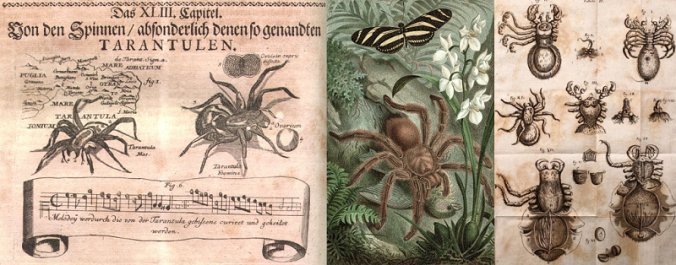
It will remain forever unclear what symbolism the young Alessandro Falchi discovered in Nietzsche’s tarantula. According to Jung, “the tarantula represents one of the many aspects of the inferior man, and if the inferior man bites him, and pours his shadow into his face, it has surely gotten at him and then he becomes the shadow. He himself now plays the role of the tarantula: he becomes poisonous, and his ressentiment is manifest even against people to whom he cannot deny a certain amount of merit.” But this is cryptic blather, and not of much help. Nietzsche’s own passage is equally enigmatic:
“And then the tarantula, my old enemy, bit me. With godlike assurance and beauty it bit my finger. ‘Punishment there must be and justice,’ it thinks; ‘and here he shall not sing songs of enmity in vain.’ Indeed, it has avenged itself. And alas, now it will make my soul, too, whirl with revenge. But to keep me from whirling, my friends, tie me tight to this column. Rather I would be a stylite even, than a whirl of revenge. Verily, Zarathustra is no cyclone or whirlwind; and if he is a dancer, he will never dance the tarantella. Thus spoke Zarathustra.”
Next post in the chronology of events
Next immediate post: a digression to address some questions and comments
